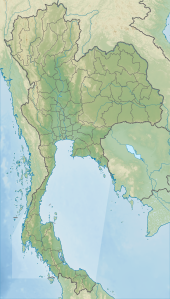Sai Thong National Park (Thai: อุทยานแห่งชาติไทรทอง) is a national park in Thailand's Chaiyaphum Province. This mountainous park features waterfalls, scenic viewpoints, and a seasonal flower field.[2]
| Sai Thong National Park | |
|---|---|
| อุทยานแห่งชาติไทรทอง | |
 Krachiao blossoms | |
| Location | Thailand |
| Nearest city | Chaiyaphum |
| Coordinates | 15°52′17″N 101°30′54″E / 15.87139°N 101.51500°E |
| Area | 319 km2 (123 sq mi) |
| Established | 30 December 1992[1] |
| Visitors | 51,233 (in 2019) |
| Governing body | Department of National Parks, Wildlife and Plant Conservation |
Geography
editSai Thong National Park is about 70 kilometres (40 mi) west of Chaiyaphum town in the Nong Bua Rawe, Thep Sathit, Phakdi Chumphon and Nong Bua Daeng Districts of Chaiyaphum Province. The park's area is 199,375 rai ~ 319 square kilometres (123 sq mi).[3] The park is in the Phang Hoei mountain range and the park's highest point is Khao Phang Hoei at 1,008 metres (3,307 ft).[2] Numerous tributaries of the Chi River have their source within the park's boundaries.[1] The park's forest types consist of mixed deciduous, dipterocarp and dry evergreen forest.[1]
Previous inhabitants
editShortly after Sai Thong was established in 1992,[4] the forest dwellers who had lived there before the park was created, had their dwellings and lands annexed by the park. Indigenous forest dwellers, whose forebears were living in the area before Thailand came into being, were deemed criminals subject to imprisonment. More than 10 million persons in some 2,700 forest communities across Thailand face eviction and legal sanctions. More than 7,000 villagers are sent to jail each year for park encroachment. Forest evictions, often violent, have increased following the 2014 Thai coup d'état under the junta's "forest reclaiming" policy. The current (2019) national park law that criminalizes forest dwellers will soon be replaced by a new version that is even more oppressive. The new law gives forest officials the power to summon people for questioning and to enter their homes at any time. They will be empowered to destroy dwellings in the forest at will. Penalties will include jail sentences of up to 20 years and maximum fines of two million baht.[5]
In 2018, 14 cassava-growing peasants, nine of them women, were found guilty by a lower court of encroaching on Sai Thong National Park after forestry authorities filed complaints against the villagers for refusing to leave. The villagers were ordered to pay compensation fees for environmental degradation ranging from 40,000 to 1.58 million baht (US$1,300-51,000) for 1 to 48 rai (0.16-7.7 hectares) of land use. Those charged with refusing to leave had settled there in the 1970s, before the national park was established in 1992.[6][7]
See also
editReferences
edit- ^ a b c "Sai Thong National Park". Department of National Parks (Thailand). Archived from the original on 14 July 2014. Retrieved 23 June 2014.
- ^ a b "National Parks in Thailand: Sai Thong National Park" (PDF). Department of National Parks (Thailand). 2015. pp. 158–159. Retrieved 20 June 2017.
- ^ "ข้อมูลพื้นที่อุทยานแห่งชาติ ที่ประกาศในราชกิจจานุบกษา 133 แห่ง" [National Park Area Information published in the 133 Government Gazettes]. Department of National Parks, Wildlife and Plant Conservation (in Thai). December 2020. Retrieved 1 November 2022, no 77
{{cite web}}: CS1 maint: postscript (link) - ^ Le, Lam; Thanasin, Phasiree (2 February 2020). "For Thailand's female land rights defenders, activism is a dangerous and daunting necessity". South China Morning Post. Retrieved 2 February 2020.
- ^ Ekachai, Sanitsuda (10 June 2019). "Why violence persists in our forests". Opinion. Bangkok Post. Retrieved 10 June 2019.
- ^ Lamubol, Suluck (1 August 2019). "Thailand penalizes peasants, not real climate offenders". Asia Times. Retrieved 1 August 2019.
- ^ On-in, Kittiya (21 August 2019). "What happened to the 14 villagers: The Forest Reclamation case of Sapwai community, Chaiyaphum Province". Pratchatai English. Retrieved 23 August 2019.
